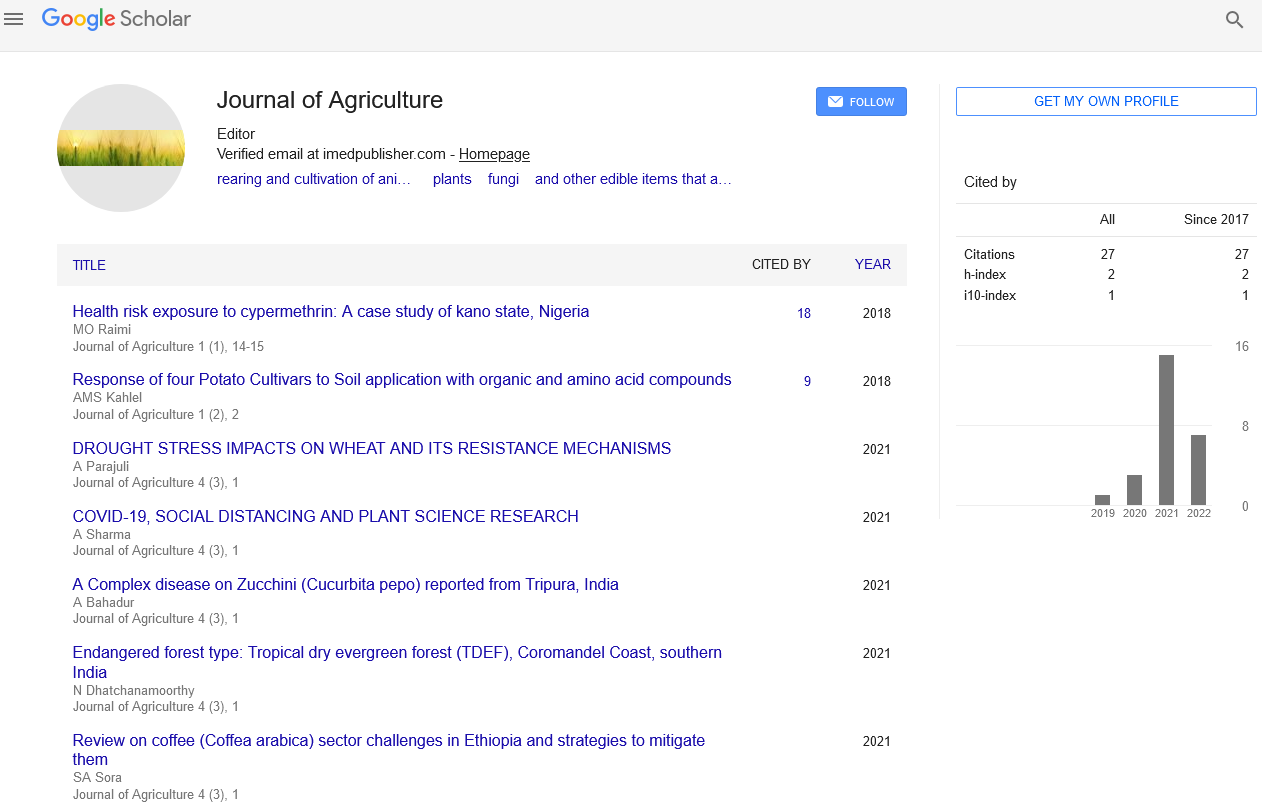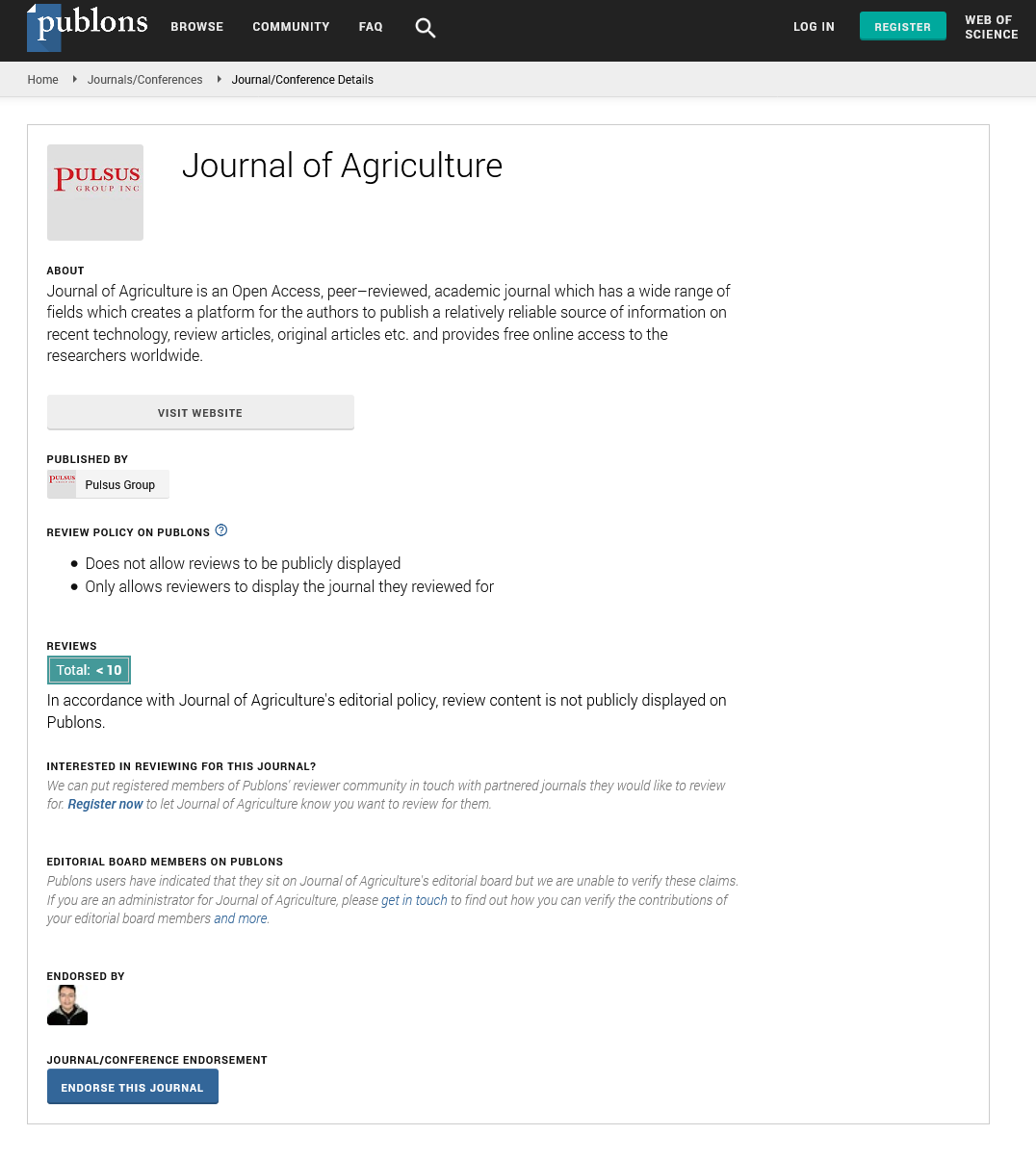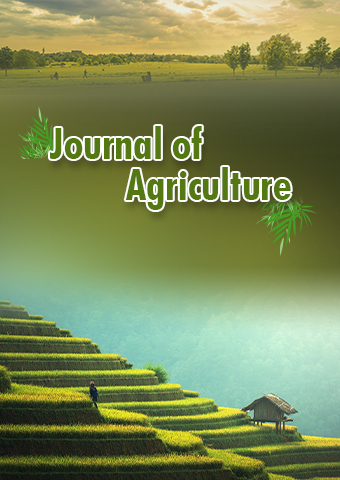Editorial - Journal of Agriculture (2023) Volume 6, Issue 4
Advancements in Plant Breeding and Genetics: Cultivating a Greener Future
Pengfei Fan*
Sichuan Management & Monitoring Center Station of Radioactive Environment, China
Sichuan Management & Monitoring Center Station of Radioactive Environment, China
E-mail: Pengfeifan65@gmail.com
Received: 01-Aug-2023, Manuscript No. jagri-23-108484; Editor assigned: 03-Aug-2023, Pre-QC No. jagri-23-108484 (PQ); Reviewed: 17- Aug-2023, QC No. jagri-23-108484; Revised: 22-Aug-2023, Manuscript No. jagri-23-108484 (R); Published: 29-Aug-2023; DOI: 10.37532/ jagri.2023.6(4).94-96
Abstract
Plant breeding and genetics have been instrumental in revolutionizing agriculture, contributing significantly to food security, nutrition, and sustainable development. This abstract aims to provide a comprehensive review of the key concepts, methodologies, and applications in the field of plant breeding and genetics. The foundation of plant breeding lies in the understanding of genetics, heredity, and variation within plant populations. Classical breeding techniques, such as selection, hybridization, and backcrossing, have been the backbone of agricultural improvements for centuries. However, recent advancements in molecular biology, genomics, and biotechnology have propelled plant breeding into the realm of precision and molecular breeding. Genetic resources, including wild relatives and landraces, have become vital in expanding the genetic diversity of cultivated crops. By tapping into these resources, breeders can develop varieties that are more resilient to biotic and abiotic stresses, exhibit superior nutritional content, and possess desirable agronomic traits. Furthermore, modern breeding approaches, such as marker-assisted selection (MAS) and genomic selection, have expedited the development of superior cultivars by enabling the identification of favourable genes and traits more efficiently. Additionally, genetic engineering and gene editing techniques have opened doors to precise trait manipulation, addressing challenges like disease resistance, drought tolerance, and enhanced productivity.Beyond traditional crops, plant breeding and genetics have found application in non-conventional areas, including ornamental plants, bioenergy crops, and pharmaceutical plants, widening the scope of agricultural innovation and diversification. Alongside these advancements, plant breeders and geneticists also face ethical and regulatory challenges concerning the release of genetically modified organisms, patent rights, and intellectual property protection.
Keywords
Plant breeding • Genetics • Genetic engineering • Modified organisms • Global food security
Introduction
Plant breeding and genetics play pivotal roles in shaping the agricultural landscape, as well as the world’s food security and environmental sustainability. These scientific disciplines focus on developing improved plant varieties with desirable traits, resilience to climate change, and enhanced nutritional value. Over the years, significant advancements in technology and research have propelled the field forward, ushering in an era of precision agriculture and sustainable crop. the remarkable successes achieved through plant breeding and genetics, as well as the potential benefits that these technologies hold for the future of agriculture and food production. It will also address the importance of responsible research and development to ensure the sustainability, safety, and equitable distribution of genetically improved plant varieties [1,2].
In conclusion, the integration of plant breeding and genetics has ushered in a new era of agricultural progress, shaping the future of global food security and environmental sustainability.
Traditional plant breeding
Traditional plant breeding has been practiced for thousands of years, where farmers and horticulturists selectively crossed plants with desired characteristics to produce offspring with preferred traits [3]. This process involved careful observation and the manual transfer of pollen between plants. While effective, traditional breeding methods were time-consuming and limited in the scope of traits that could be targeted.
Genetic discoveries
The 20th century brought about groundbreaking discoveries in genetics, including Gregor Mendel’s foundational work on the principles of inheritance. These discoveries laid the groundwork for modern plant breeding practices. In the 1950s, the discovery of the DNA structure by Watson and Crick unlocked a new era in genetics, allowing scientists to delve into the molecular basis of heredity [4].
Hybridization and hybrid vigor
The concept of hybridization revolutionized plant breeding. Hybrid varieties, produced by crossing genetically diverse parents, demonstrated a phenomenon known as hybrid Vigor or heterosis. This characteristic resulted in offspring that exhibited superior traits, such as higher yields, increased disease resistance, and improved stress tolerance [5].
Biotechnology and genetic engineering
The advent of biotechnology and genetic engineering marked a transformative stage in plant breeding. Scientists gained the ability to manipulate genes directly, enabling the introduction of specific desirable traits into plants. Genetically modified organisms (GMOs) were developed with traits like pest resistance, herbicide tolerance, and increased nutritional content. While GMOs sparked debates about safety and environmental concerns, they undeniably provided tools to enhance crop performance [6, 7].
Marker-assisted selection (MAS)
Marker-Assisted Selection (MAS) emerged as a crucial technique that allows breeders to select plants with desired traits more efficiently. Instead of relying solely on phenotypic characteristics, which can take years to manifest, MAS employs genetic markers linked to target traits. This expedites the breeding process, resulting in the development of improved varieties in a shorter timeframe [8].
Genome editing techniques
More recently, genome editing technologies like CRISPR-Cas9 have transformed plant breeding. CRISPR allows precise modifications of specific genes, without introducing foreign DNA as in traditional genetic engineering. This technique has vast potential for creating crops with enhanced traits, such as increased nutritional content, disease resistance, and improved environmental adaptation [9].
Data-driven breeding and AI
The integration of data-driven approaches and artificial intelligence (AI) has revolutionized plant breeding. Sophisticated algorithms analyze vast datasets, including genomic information, environmental factors, and historical crop performance data. AI helps predict the most promising crosses, shortening the breeding cycle and increasing the chances of developing highperforming varieties [10].
Conclusion
Plant breeding and genetics have come a long way from traditional selection methods to sophisticated genetic engineering and AIdriven predictions. These advancements have allowed breeders to develop crops that can thrive in challenging environments, resist diseases and pests, and meet the nutritional demands of a growing global population. As technology continues to evolve, plant breeders are better equipped to address future agricultural challenges, ensuring a greener and more sustainable future for all.
References
- Davies W, Paul J. An historical perspective from the green revolution to the gene revolution. NutrRev. 61, 124-134(2003).
- Sunny A, et al. Conventional and molecular techniques from simple breeding to speed breeding in crop plants: recent advances and future outlook.IntJMolSci. 21, 2590 (2020).
- Moose SP, Mumm RH. Molecular plant breeding as the foundation for 21st century crop improvement.Plant physiology,147,969-977(2008).
- Dempewolf H, Baute G, Anderson J et al. Past and future use of wild relatives in crop breeding.Crop Sci.57, 1070-1082(2008).
- Muthamilarasan M, Prasad M. Advances in Setaria genomics for genetic improvement of cereals and bioenergy grasses.TheorApplGenet.128, 1-14(2015).
- Matin Q. Role of new plant breeding technologies for food security and sustainable agricultural development.Applied Economic Perspectives and Policy42, 129-150 (2020).
- Maarten K, Stam P. Changing paradigms in plant breeding. Plant Physiol. 125,156-159(2001).
- Zamir D. Improving plant breeding with exotic genetic libraries.Nat Rev Genet.2,983-989(2001).
- Rajeev K, Yu J, Mark E et al. Designing future crops: genomics-assisted breeding comes of age.Trends Plant Sci. 26, 631-649 (2021).
- Morrell PL, Edward S, Ibarra JR et al. Crop genomics: advances and applications.Nat Rev Genet. 13, 85-96 (2012).
Indexed at, Google Scholar, Crossref
Indexed at, Google Scholar, Crossref
Indexed at, Google Scholar, Crossref
Indexed at, Google Scholar, Crossref
Indexed at, Google Scholar, Crossref
Indexed at, Google Scholar, Crossref
Indexed at, Google Scholar, Crossref
Indexed at, Google Scholar, Crossref
Indexed at, Google Scholar, Crossref


